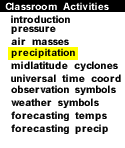
|
Introduction:
Precipitation develops from upward moving air.
As the air rises, it cools and the water vapor condenses to form
cloud droplets and eventually, precipitation.
Upward motion typically occurs along
frontal boundaries as air masses of different densities clash.
A less dense air mass is lifted by a more dense air
mass, leading to the development of precipitation.
The purpose of this activity is to introduce how precipitation develops along cold fronts and along warm fronts. Two animations have been constructed to visualize these distinctly different processes and students will use this information for comparison. Key words throughout this activity link directly to helper resources that provide useful information for answering the questions.
Precipitation Along Cold Fronts:
1) The diagram below is a vertical cross-section through two air masses
and the frontal boundary separating them.
Fill in the missing components
(the white boxes) of this diagram.
You may label the diagram
in one of two ways; 1) by printing out a copy of this activity and marking your
answers directly onto the printout or 2) by saving the image into your favorite
graphics software and modifying the image using that graphics package.

Using this animation for reference,
write a paragraph describing
how precipitation develops
along a cold front. Be sure to keep in mind the following points:
- the shape of the cold front (vertical structure)
- strength of upward motions
- location and intensity of precipitation
- types of precipitation that commonly develop along cold fronts
Precipitation Along Warm Fronts:
2) As in question #1,
the diagram below is a vertical cross-section through two air masses
and the frontal boundary separating them.
Fill in the missing components
(the white boxes) of this diagram.
You may label the diagram
in one of two ways; 1) by printing out a copy of this activity and marking your
answers directly onto the printout or 2) by saving the image into your favorite
graphics software and modifying the image using that graphics package.

Use this animation for reference,
write a paragraph describing
how precipitation develops
along a warm front. Be sure to keep in mind the following points:
- the shape of the warm front (vertical structure)
- strength of upward motions
- location and intensity of precipitation
- types of precipitation that commonly develop along warm fronts
Comparing Warm Fronts and Cold Fronts:
3) Using your solutions from questions #1 and #2,
write a paragraph comparing
the development of precipitation along warm fronts with cold fronts. Some
issues to keep in mind include:
- how the air is lifted
- strength of the upward motions
- type and intensity of precipitation that develops

air masses |
|

midlatitude cyclones |



